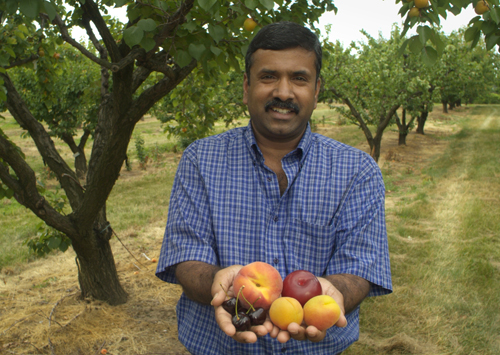By Alaina Osborne, Students Promoting Awareness of Research Knowledge (SPARK)

Researchers are looking at ways to brighten up the colour – and the image – of prunes.
The fruits, which are dried and dehydrated European plums, offer many health benefits, such as improving eye sight, boosting metabolism and controlling blood pressure. But consumers often shun them because they are mainly associated with relieving constipation.
Plant agriculture professor Jay Subramanian wants to change that. He’s working with the Vineland Research and Innovation Centre to develop new varieties of European plums, alter their blue colour and extend their relatively short growing season.
“Our aim is to produce multiple varieties that fruit earlier to cover the entire window of harvest and allow for more local produce,” he says.
These yellow European plums (YEPs) would offer Canadian growers a chance to compete in the mainly U.S.-based marketplace, particularly from early to late July.
Subramanian believes these varieties will attract more consumers. The fruits are less bitter and develop a brighter hue than the typical blue European plums, which turn black when dried, creating an unappealing look and often bitter aftertaste.

Yellow European plums have similar levels of natural antioxidants found in traditional prunes, but without the dark colour or bitterness. Yellow and golden prunes also share the blue plum’s high level of vitamin C, iron, potassium and fibre.
The idea to revamp the prune’s image first came to Subramanian after seeing photos comparing dark-coloured raisins with their younger, greener counterparts.
“When I saw what had been developed with other fruits, I thought, why can’t we do the same with prunes?” he says. “Instead of looking down at the prune, we could offer Ontario a new and unique product.”
Transforming the prune into an appealing fruit is not an easy task, however.
Tree fruit breeding, which can take up to 20 years, is a painstaking process involving extensive manual labour.
After selecting parent plants with desirable traits, such as fruit size, colour and growing season, researchers at Vineland hand-pollinate some 50,000 flowers. As plums continually drop fruits during development, only about 10 per cent of these flowers reach maturity, and researchers are lucky if they get 300 viable seeds to test. If the weather is too cold or rainy, the whole year’s harvest may be lost.
The Vineland team tries to make prunes from YEPs naturally by drying them in a controlled manner without adding sulphite. Normally, this compound is added to prevent browning (the reaction that occurs when the inside of the fruit meets oxygen in the air). Sulphite poses a problem for the increasing number of people who are allergic to it. Subramanian is instead looking to replace sulphite with natural alternatives, such as vitamin C.
For now, the YEPs are still in the early stages of development, but if all goes well, these locally grown fruits will benefit Canadian growers and consumers alike.
“It’s like an ugly duckling becoming a beautiful swan,” says Subramanian. “YEPs and golden prunes have huge potential.”
His research is supported by the Vineland Research and Innovation Centre, the Ontario Ministry of Agriculture and Food, and the Ministry of Rural Affairs.